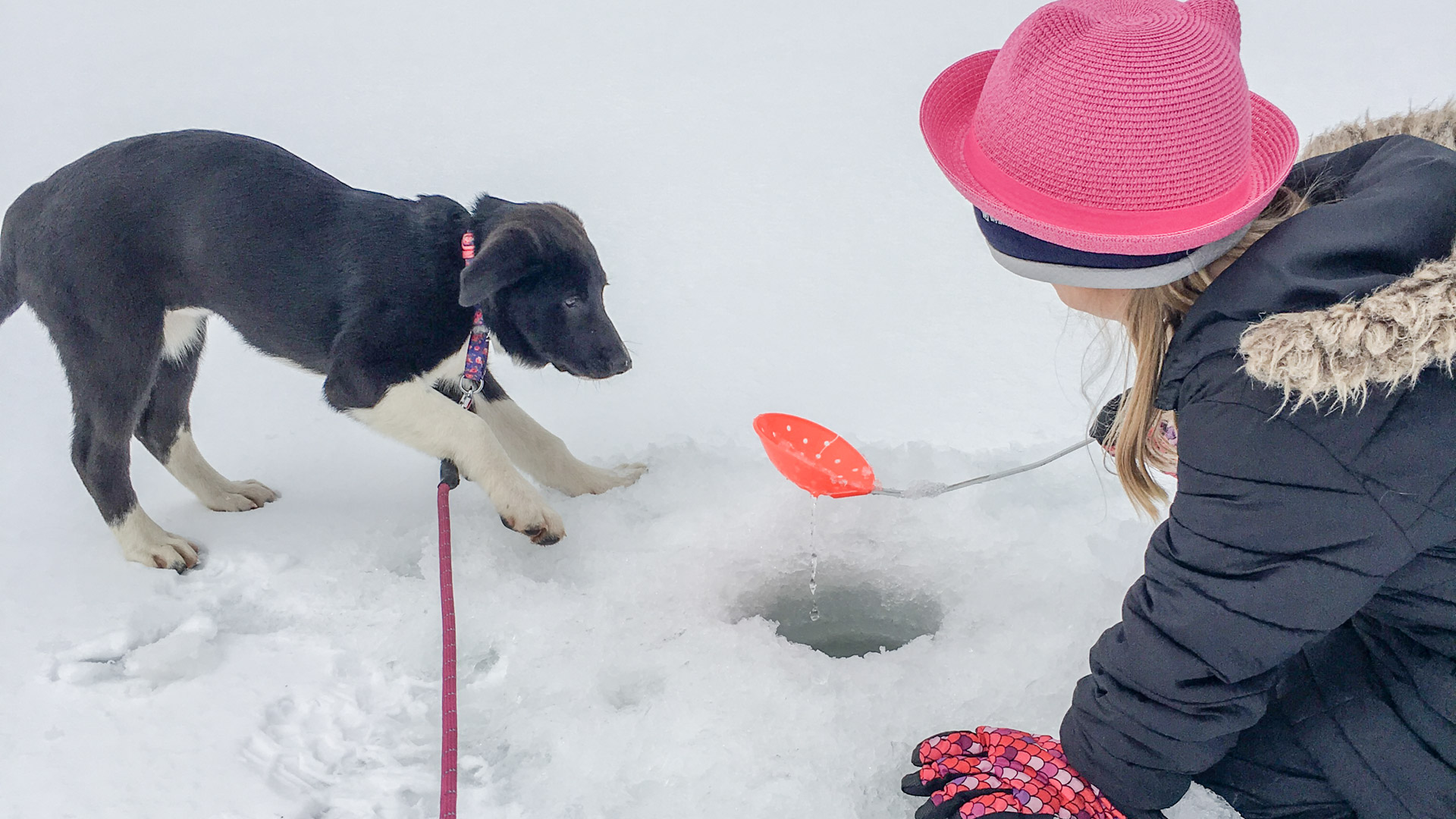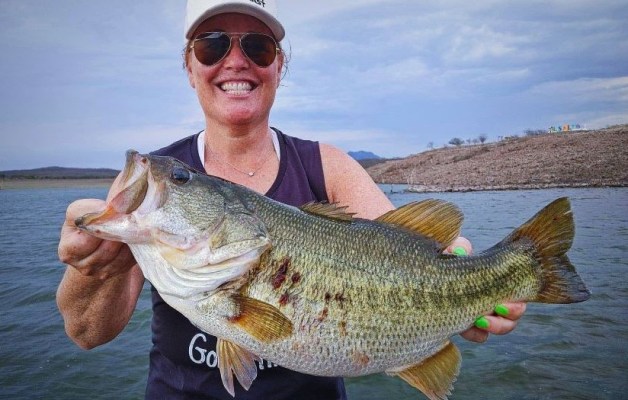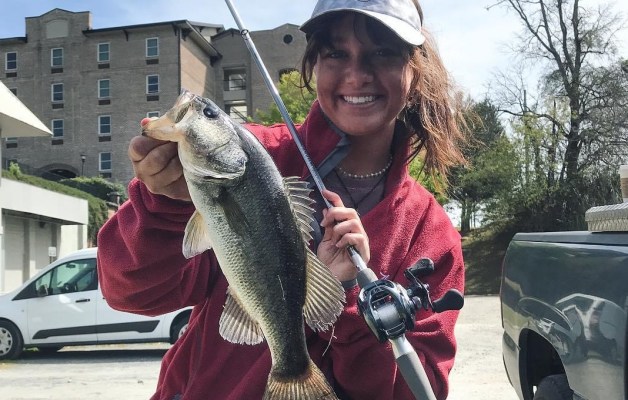
If you are lucky (or unlucky) enough to live within the ice belt, ice fishing is probably something you have heard about and maybe even participated in. It’s a fun way to enjoy some time out of the house and an easy way for everyone to catch some fish. It may seem expensive to get the family out on the ice, but it is much cheaper than you think. Although most of the equipment does differ from your normal fishing gear, anglers can get started for a couple hundred bucks.
Let’s take a look at and answer some questions you may have when first learning to ice fish.

What gear will I need?
There is an overwhelming amount of gear made for ice fishing and it all has a time and place. The list goes on and on of the gear that you could buy, but we’ll help you break it down and select the best gear for learning how to ice fish without breaking the bank. Utilizing the right gear will help you have a successful day on the ice.

- Auger: An auger should go without saying. Any of the other gear you will need is useless without being able to drill a hole. Augers range in size but the most common are 4-inch, 6-inch, and 8-inch. The smaller ones will work for panfish while the bigger ones are necessary for landing large fish.
- Jigging rod: Whether you plan to use tip-ups or not, the jigging rod is one thing that you absolutely need to have. It is much more fun for kids and beginners as it requires some action to use. It is as simple as dropping the bait through the hole and waiting for a bite. Panfish are plentiful in most bodies of water and are usually quick to bite.
- Tip-ups: Tip-ups are not necessary if you have jigging rods but are a great addition on the ice. They are great for covering water and are simple to use. Hook on your bait of choice, usually a minnow or other live bait, set the bait to the desired depth and wait. When you get a strike, the flag will tip-up and you can go and reel it in.
- Bait: Depending on if you choose tip-ups or a jigging rod, you will need live bait, artificial bait or both. Tip-ups generally are rigged with a minnow or some sort of live bait while jigging rods are mostly rigged with artificial. More to come on bait selection below.
- Shanty: Depending on the weather, a shanty may or may not be needed. However, it is always a good idea with kids or beginners to make sure they are comfortable. There is a good chance it will be cold outside, and a shanty will keep you warm and able to fish longer.
- Spud bar/Ice spikes: It is good practice, especially when you don’t know the ice conditions, to check as you walk and make sure you’re on safe ice. A spud bar is dropped down to the ice and chips away ice chunks so you can tell you are on safe ice. If you are familiar with the ice conditions or are going with a professional, you probably don’t need to bring this along. When in doubt, bring it.
- Flasher/Fish finder: Again, not totally necessary, but if you have access to one or find one for sale, it will help you catch fish. The main thing with a flasher is you can easily check depth, which is important for different species. You can also see fish on a flasher, and it makes it really fun and engaging for beginners to learn how fish react to your baits. For a couple hundred bucks, keeping beginners interested will make the trip more enjoyable.
- Ice sled: You need to bring all your gear to and from the ice and there is no better way than a sled. Anything to help organize gear and ease the transportation will make your trip better. Some ice sleds double as a shanty which kills two birds with one stone. A quick flip-over shanty makes it easier than setting up a hub-style shack.
- Snacks: Having food and water with you on your ice fishing adventure is almost as important as the auger. Being comfortable is a necessity and food and drinks are a kid’s best friend.
- Warm clothes: Yes, it is called ice fishing for a reason. It is winter and the temperatures are cold. You may have a shanty or a heater going, but warm clothes will keep kids and beginners comfortable. Snow pants and a winter jacket, gloves (bring two pairs) and a hat are definitely needed. Plus, kids love to play around on the ice when they get bored.

What should I use for bait?
Once again, without bait, there is no fishing. Your bait selection does not have to be complex, but it is important to research and see what you should bring. Live bait and artificial baits can be purchased at your local tackle shops or you can choose to utilize Beginner Ice Fishing Kits such as the Tailored Tackle Ice Kit. These kits make it very easy to get what you need in one box and the Ice Fishing Quick Guide will help you learn how to use different baits and decide which is best for your body of water. Tip-ups are mostly used with live bait, while jigging rods work best with artificial baits. A great way to learn about what baits you should try is by visiting your local tackle shop. The employees are usually knowledgeable and can point you in the right direction.
Tip-up bait
The most common bait for a tip-up is live bait. Minnows are the most common and range in size from small enough to catch panfish to bigger minnows for larger species like pike. If live bait is not legal in your state, you can get frozen bait as an alternative or use your own cut bait. For bigger fish like bass, pike or walleye, large minnows or baitfish are the best options. Shad, perch or a sucker on a tip-up will work well. You can also use worms, mealworms, power bait, grubs or salmon eggs. Do a little research for your body of water and choose the bait that will work best.
Jigging bait
For jigging rods, the most common bait is small jigs, small soft plastics and small flutter spoons. With these 3 items, you can catch panfish almost anywhere. Pair the small jigs with either live or artificial bloodworms, grubs or even a small minnow. Soft plastics come in a lot of different colors, but as a rule of thumb, panfish like bright colors. Soft plastics are also made to glow, which in deeper depths will help get more bites. Small flutter spoons are made to mimic shad and other small minnows. They have lots of flash and are available in many different sizes, shapes and colors.
Where should I fish? Selecting a spot
After you get your gear sorted, you will need to select a destination. If you are within the ice belt, ice fishing happens on most still bodies of water. Your closest lake, pond or reservoir should have ice and you can always check with your local bait shop to help choose a place to go and learn of ice conditions. Try to select a lake you are familiar with if possible, so you have an idea of the fish you could catch and where to park to access the lake. Where you fish on the lake can be dictated by the type of fish you want to catch, and sometimes you have to be mobile to stay on fish.
To begin, it is helpful to do a little research on the body of water you choose to fish. There is a lot of information about the depth and size of lakes online and oftentimes you can find fishing reports from local guides that will help you catch fish. Because panfish travel in schools, and there are lots of them, they are easier to find. In general, panfish can be jigged in deeper water while larger species such as pike/pickerel can be caught on a tip-up in shallower water.

Panfish
Panfish will be the easiest fish to catch with the family, and for beginners, there is nothing better. Usually, panfish will be in big schools and when you find them, you can catch them fairly regularly. Choosing a spot for panfish such as perch or bluegill is much easier than looking for larger species. Panfish in the winter will be near small baitfish such as small minnows and plankton, and they like deeper mud bottom areas.
If you know nothing about your body of water, starting your day in the deepest areas on the lake is a good bet. Panfish prefer the basin or deeper weed edges depending on the time of the year. First ice, early season, I like to start deep and work shallow. Last ice, late season, I work shallow to deep. If you have a flasher, you can find fish faster, but simply fishing will tell you if you are around panfish or not. If they are there, they will bite.
Larger species
I am not going to get too in-depth about catching all of the larger species in the lake, as some are more difficult to find and catch. For a beginner, especially kids, it is not as fun right away. Tip-ups are more difficult to use when you are moving around searching for fish. However, if you have access to tip-ups and some live bait, it is worth the effort to set a few and try to catch a couple pike, pickerel, trout, bass or other larger fish. Simply spread the tip-ups around your preferred fishing area and look to place them in different depths. If you have a couple, place one in shallow water and one deep. If you have multiple people and several tip-ups, make a few lines from shallow to deep and look to focus on deeper weed edges on flats.
How to catch and land fish?
The last thing to do once you gather the appropriate gear and pick out a body of water is go and enjoy catching fish. Getting everyone ready, gathering the proper gear and getting out on the ice is a big step and now you want to make sure the trip is a success. Whether you choose to utilize a small jigging combo, tip-ups or both, there are things you need to do to ensure the family catches a few fish.
While jigging for panfish is the easiest way to introduce a beginner to ice fishing, sometimes the proper cadence is needed to entice a bite. There are days when you can simply drop a small jig down and get a bite with zero effort, but learning how to work the bait will yield more bites. Likewise, you can employ a series of tip-ups in the right location. If you have the wrong bait or your bait is at the wrong depth, you will get less bites.
Here are a few tips to help you catch some fish through the ice.
Jigging gear
- When rigging your first ice rod, look for 2- to 4-pound-test line. Lighter line will be less likely to tangle and will yield more bites from sometimes pesky panfish.
- When using a small ice jig, you can either use a live wax worm (spike), a small soft plastic or both. Don’t be afraid to change baits and combinations until you find what works.
- A quick Google search will yield many different baits that are proven for panfish. Do a little research or stop into your local tackle store and talk to them about what may work for a beginner. Some baits have a lot more flash or rattle to them but the idea is the same.
- Drop your bait to the bottom and slowly work the rod tip with a subtle pulsing motion to give the bait some action. As panfish tend to feed upward in the water, lift the jig up off the bottom and pulse slowly while working the bait upward. Stop the bait now and watch the rod for a bite. While the bait is moving upward in the water, panfish tend to follow it and will bite while it’s stationary.
- If you don’t get a bite, drop it back down to the bottom. The motion of a bait falling to the bottom, stirring up the mud or silt, draws attention to panfish and will draw them in.

Tip-up gear
- When setting tip-ups, opt for a grid or diamond pattern to effectively cover water. Drill your holes 30 to 40 yards apart and you can jig within the tip-ups. Sometimes, jigging will attract fish, and if they don’t like your setup, oftentimes they will see a live minnow on the tip-up and bite.
- Keep a good eye on your tip-ups and regularly check them to ensure the bait is still alive and swimming. When you get a flag, make sure you are within a reasonable distance to go and check for a fish.
- If you found a couple sets of old tip-ups in your grandfather’s shed or you just purchased a couple, it probably has an ice fishing line on the spool. Ice line is a strong braid-like fibrous line that is highly visible to fish. Rather than use as-is, use a fluorocarbon leader. Fluorocarbon line is nearly invisible in the water and the fish will be more apt to come check out your bait without being spooked.
- Because tip-up bait is often just “hanging out” below the ice, fish have a lot of time to inspect the bait before deciding to bite or not. To avoid fish swimming away without your bait, use as small of a treble hook as you can with bigger baits. For smaller minnows to panfish, use a small circle hook.
- When you see a flag, it’s tempting to run over and grab the line and try to yank right away. With a tip-up, you only want to yank when you can feel the weight of the fish. Slowly pull the line until you can feel the weight of the fish, then give it a good yank and fight the fish.





